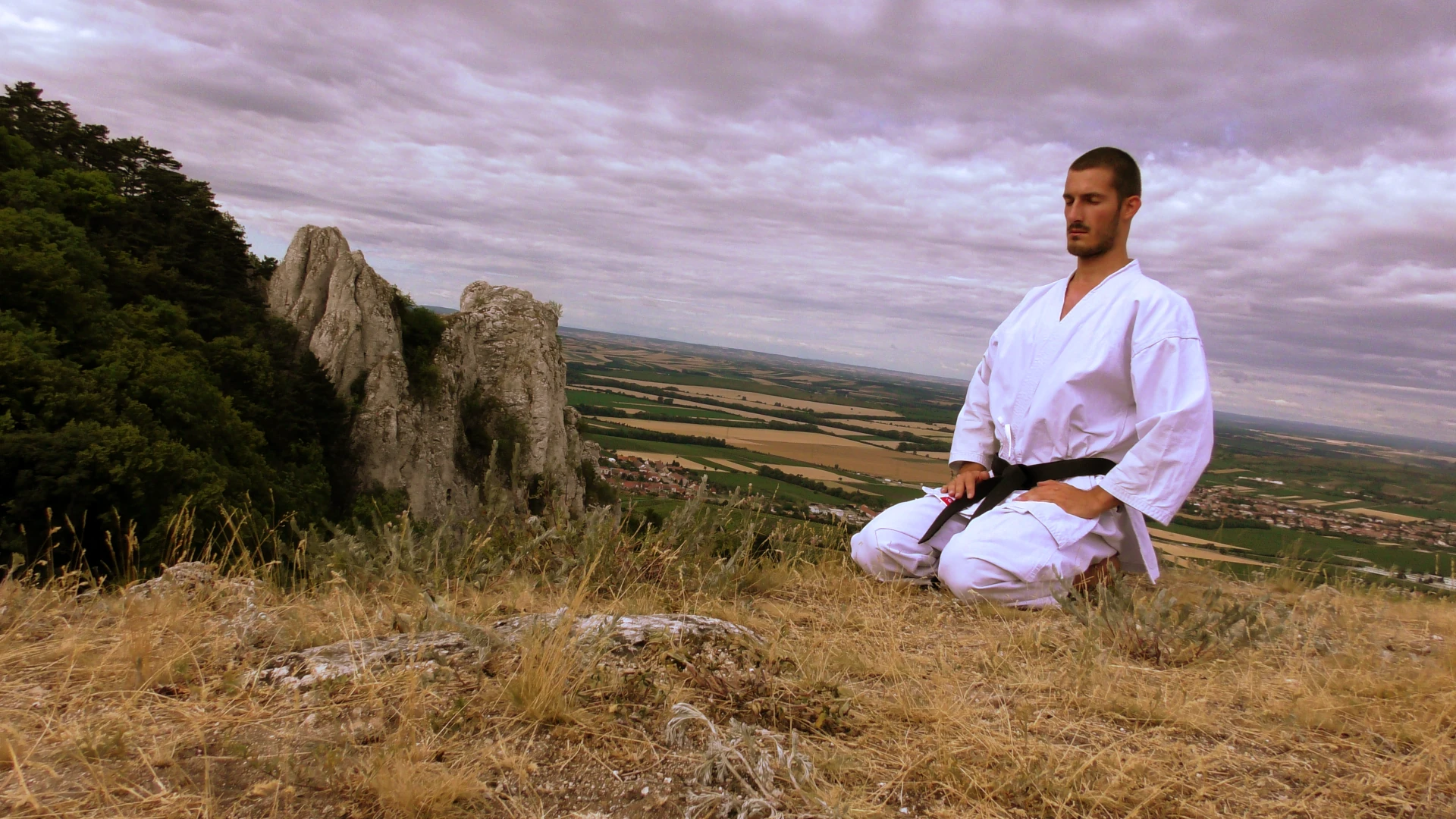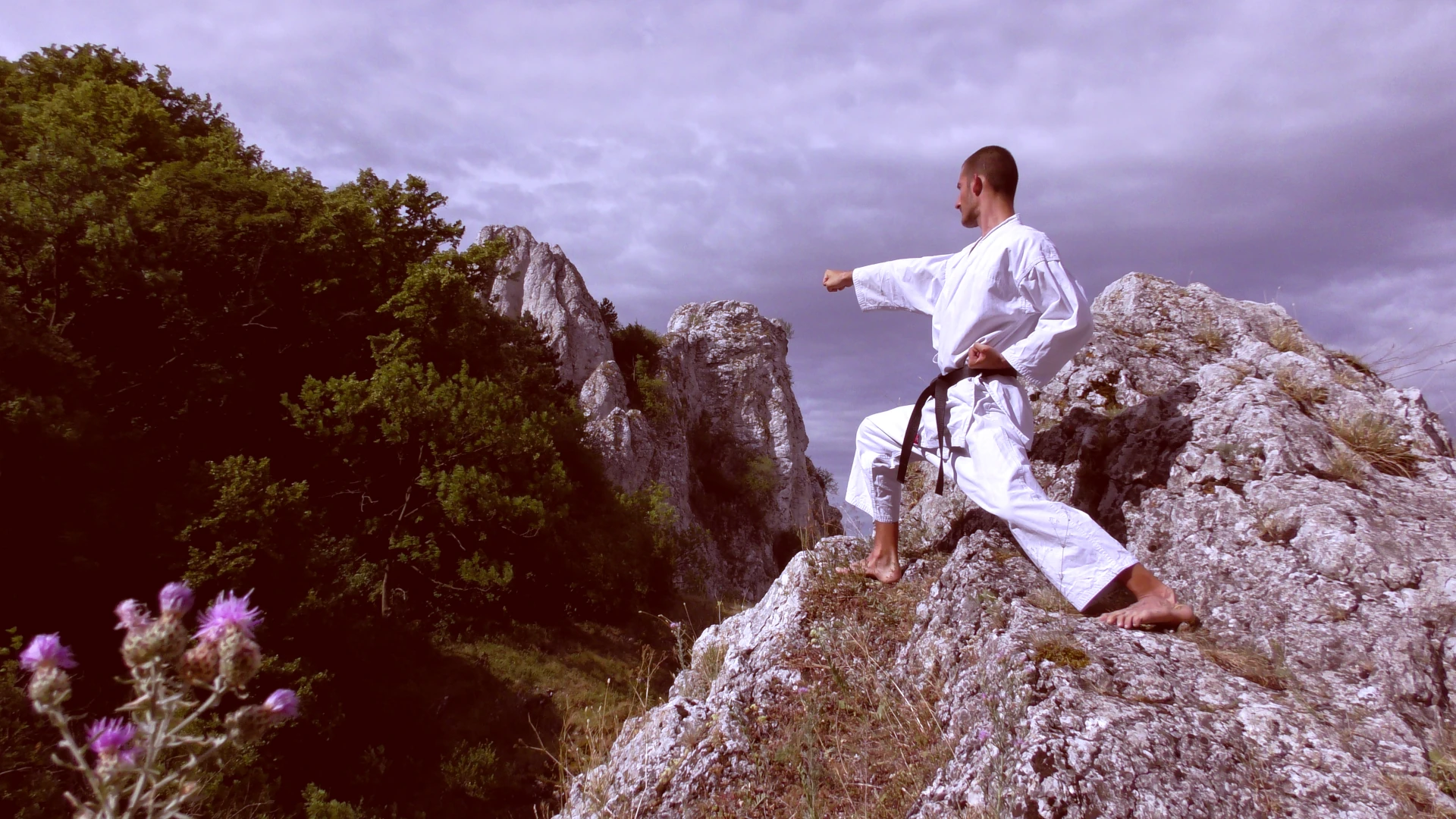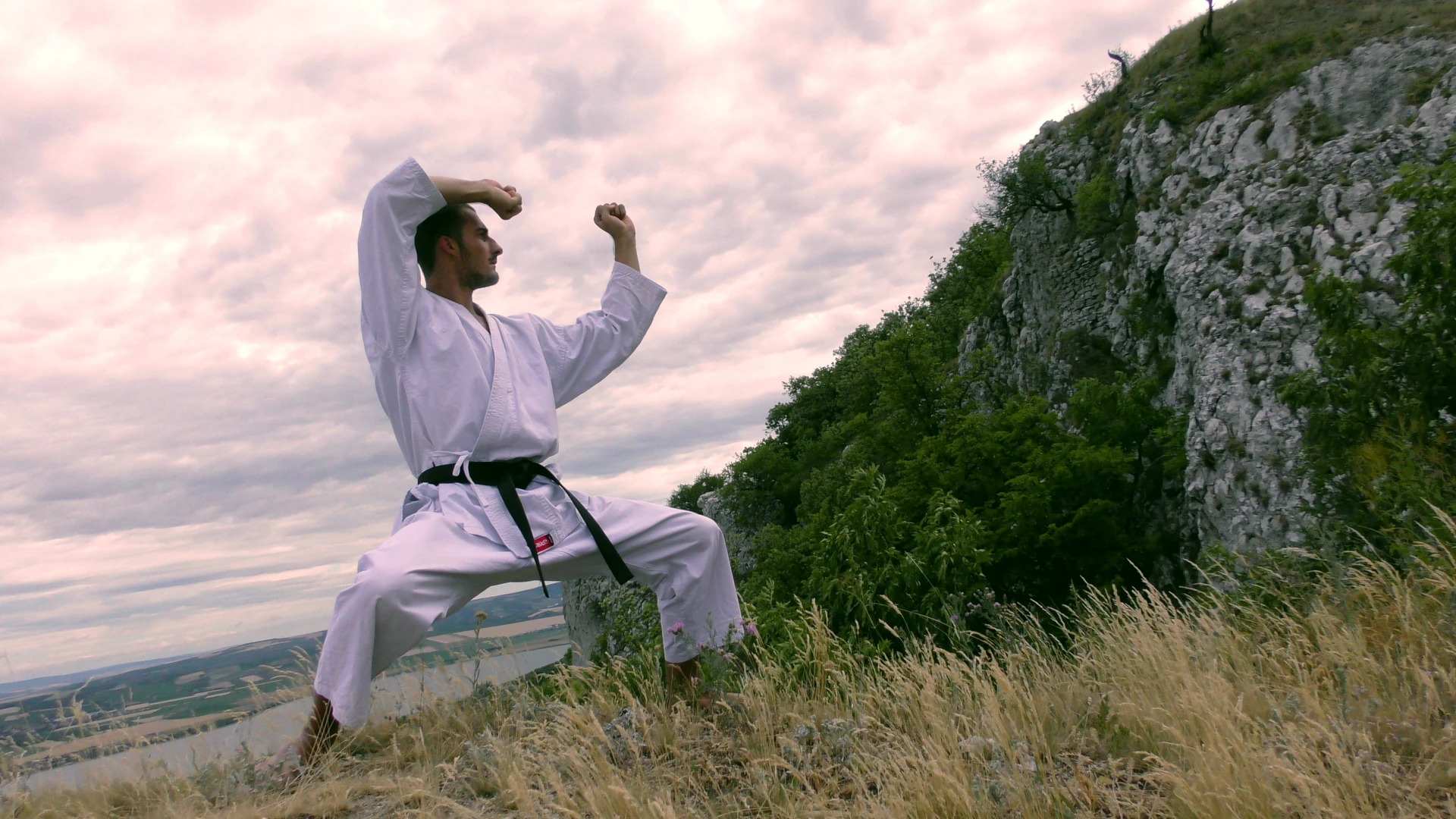Relaxation in Karate and Natural Technique and Mind in Martial Arts
This article is about the principle of being natural and relaxed physically and mentally not only in karate but in all martial arts. At the time of writing this article, I have been training karate for almost 20 years and now I have a second black belt Nidan (二段) in Shotokan. I have met many people in the dojo, most of them came and left. When new people come, they are often amazed by people like me who have trained for many years. Some people even called me talented, but the truth is that the only thing I am good at is staying :D. Just naturally continuing what I started. And this is what this article is about, being natural in martial arts.
When you do something for many years, your body just gets used to it. That's all there is to know. There are various training plans, theories about what is and what is not effective but I often saw these things as a kind of try-hard approaches. Karate became a huge part of my life and affected me in many ways, even those that I am not aware of. But this is exactly the thing about Japanese martial arts. It is a way of life, Budo (武道). Have you ever noticed the ending of these martial arts? Karatedo, Judo, Aikido, Kyuido, Kendo. The do with the kanji character 道 means a way or a path. It is not an instant thing that you learn, it is a way of life. I can see it in my own life. I feel urge to train and I feel dull when I spend the whole day in front of my PC screen without a bit of exercise. Sometimes I was not feeling well both mentally of physically and I've always felt much better after a good training be it in dojo with my friends or alone in nature or at home. Dojokun by Funakoshi sensei is something I value in my heart.
Here is one training video I made with (hopefully) useful tips:
At first we try to imitate the sensei. When we come to the dojo, the more advanced practitioners show us the techniques and correct our stances and movements. This helps us to make our technique efficient since we can't feel our own body well enough to see where the problematic parts are and which techniques would not work well, for example when hitting someone or blocking an attack. Later we know the form and we are more aware of our bodies. Then we can practice our own karate.
There's the story of the black belt that says that when you first come to the dojo, you get a white belt. Later you go through all the colors until you receive the black one. Usually black belts are made from a different material so that they get torn, worn away, and chafed and the white starts to be visible through various cracks and torn away spots. In that moment, the practitioner realizes that this is actually the very first white belt he got when he or her started their first karate class and it has not changed at all. The only thing that has changed is the practitioner. This is the Shoshin (初心)) beginner's mind. Being humble and respectful is the most important thing in martial arts. Being natural, not above or below anyone else. Just a karate practitioner, no more, no less.

When we start thinking too much about our self in martial arts, we start to be distracted and tense. I have a higher belt than my opponent, it would be embarassing if I lose this kumite match! Ah sensei is watching me now, I have to perform this kata as best as I can! That guy there is full of himself, he really gets on my nerves, I have to train better than him and beat him! Always when these thoughts come to mind, the technique turn immediately much worse. The body is not relaxed enough to be natural. This reminds me of the Last Samurai where one of the samurai told the main character not to mind the sword or people around and to have no mind. Otherwise there is too much stress and anxiety in the mind and the body. This is not just in martial arts but life in general.
There is a principle in karate called Enzan no Metsuke (丸山の目付) which can be translated as gazing at distant mountains. When you watch a video of a fight, you can many times be like: What? Why didn't he see that blow? He could have evaded that to the side, make a sweep, throw the other guy down... When we are sitting safely away from the actual fight and see the whole picture from the distance, it is so easy to win, right? Enzan no Metsuke is the way to kind of simulate this state. In practice, mentally, it means not thinking of the enemy, not thinking of yourself or the techniques. Physically, it means not fixating the sight at the opponent, but rather looking behind the opponent as if focusing somewhere to the distance. Having the opponent blurred a bit as if watching him or her peripherally. This might sound counter intuitive but form my own experience I can tell that this is very effective when done properly. I remember times when I could not react well to the opponent's actions so I stopped for a few seconds, took a few breaths, and utilized this principle. The change was really significant! In other words, the whole zanshin (残心), the state of battle awareness, become much more relaxed and natural.

I have an anecdote story regarding this. Our sensei once wanted us to test our stable emotions so our task was to stand and let the opponent pretend doing various techniques while stopping them as close as possible to our bodies. This might sound silly, but it is not always easy not to even blink when a punch stops a few millimeters in front of one's eyes. Apparently, I looked like a statue so sensei told me to get in front so he would demonstrate what he meant. He did some strong techniques, shouted, did surprise attacks in the middle of talking to the others and me? I was solid as a rock! Not even blinking, my nerves were of steel! Sensei then told others "See? He has been training here for years, this is the spirit you can get by a long and intensive training!" I saw some of the other students looking at me really inspired. Well...the truth is that I was really feeling sick that day. I believe I even had a fever, probably a light flu. I barely knew what was happening around me. Just standing there like in a dream. No wonder I didn't react to anything at all! Yes, this is how legends are born! By the way, training is a great way to get rid of various diseases such as the flu or cold. Sweating and increased blood circulation can help the body regenerate and remove viruses or bacteria. Be careful not to infect others, though.
Now I would like to mention techniques and the way they are performed. After watching some videos by Hotton sensei about this topic, I tried to implement these principles in my karate. My techniques got much stronger and faster and also less tiring. The relaxation of the muscles is the key. Try it yourself, clench all your muscles and try to be move quickly. Impossible. My sensei always says Who doesn't breathe is dead! Breathing out during technique relaxes the body and makes it fast. The kime (決め) at the end of the technique makes it strong and capable of transferring all the energy gained by the speed.
To me, all techniques feel like dropping a weight and letting it fall. At first this is maybe easy to imagine with dropping techniques but hard with techniques which go up or in front of us. Later this feeling can be applied to all of them. Try to raise your hand up and then just let it fall down. Do this several times. Then add an initial impulse to it and push it along its natural path down. Stop the hand in front of your stomach with kime. You can do this in many ways, for example, letting the hand naturally swing around the body when turning around like in mawate. When done properly, one feels this feeling of an energy transfer at the area of potential impact. A bit like a whip that leads the energy to its tip. It feels like a vibration going through the body and going out through the technique at the very end. This change of relaxation and tension is in my opinion one of the most important principles of karate and many other martial arts. Relaxing, the technique is flying towards the opponent, tension at the moment of the impact for a very small amount of time, and relaxation again to be able to do another technique.
The initial impulse I mentioned which gives the energy to the technique is usually coming from inside. This is why many masters say that the center of the body, somewhere between the hips, is the most important part in martial arts. In karate techniques always start from this place. Translation of the body should be connected to the center, not starting with the upper body and not being too fast with the legs, otherwise the body feels disconnected right at the center. Rotation of the hips is another source of energy to be used when the techniques are switched and the stance changes from hanmi (open, sideways facing hips) to shomen (closed, forward facing hips) or vibration for close combat where the hips just go a little to the front to initiate the technique. Also, when performing kicks, the hips do the vibration.
When doing subsequent actions like blocking and attacking which is a common combination, the principle of a beach ball can be applied. When you press the ball, you create tension, and when you release it, the accumulated potential energy throws your hands away naturally. It is like a spring created in the body which leads to another technique. However, this chaining is not possible without the relaxation. Sometimes it feels like the body is blocking itself in the technique. Being more relaxed makes the techniques go the most natural way so the body does not spend additional energy to perform the technique, it is like a lightning during storm which goes from the clouds to the ground via the fastest possible way, or like a water which takes all possible shortcuts to flow down the mountain. Maybe this is what Bruce Lee meant by urging people to be like a water?

My other experience with this relaxation goes on in other martial arts as well. Karate is the only martial art I officially train. But as a true weeb I am also a master of sword and...nah just kidding :D. But I have experimented with other martial skills, and some are my little hobbies. I trained fencing with my friend and the same relaxation during cuts helped me in the same way as when punching, etc. The relaxation of letting go the body weight can be trained even better with a bokken or a piece of wood. Just raise it and let it fall down. Then add more momentum to it and stop at the end. The same goes for the gazing to the distance in fencing. Similarly when doing archery, the body needs to be relaxed. The back muscles hold the bow pulled and then when the arrow is released, the whole body needs to just relax. Any tension can cause a small tug of the hand holding the bow or arrow and the arrow then flies somewhere we were not aiming to. Similarly when shooting a pistol. When I am too tense, the hands get tired too quickly and the moment the bullet leaves the gun, they move it so the bullet goes sideways. Shooting instructors always say that the shot should surprise you. The hands need to be relaxed as if not expecting the impact, just being in a solid position, just like a karate stance. The various stances in karate are just optimal positions of the body for the given situation. Nothing more. Kibadachi is more stable to the sides, zenkutsudachi is good for receiving the impact from the front, etc. Another similar example is when I used to jog and tried to run for 10 km for the first time. My legs suddenly started to be so heavy and burning in pain. I was about to give up and have a rest. For some reason I got an idea to relax. I visualized letting go of the heaviness as if dropping it on the ground during the run. After this relaxation I felt much better and I made it till the end!
Sometimes it is just not our day. Sometimes we remember all these theoretical principles, but they just don't work at all. Slow reaction time, unstable stance, a lot of disturbing thoughts... Even when these times come, stay natural. This is my karate right now, disturbed, but karate anyway. Accepting the situation is a part of the strategy. Our desires often block our path. We fight our own body, we fight our own mind and then we are exhausted. As Funakoshi sensei said: True master is not the one who defeated thousands of opponents. The true master is the one who won at least once without a fight.
Osu...
Another training video in nature with kata elements:
Keywords: bushido, combat, zen, sports
#karate #karatedo #bushido #martialarts #zen
Privacy Terms